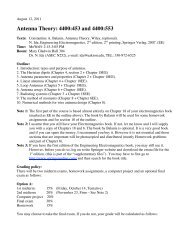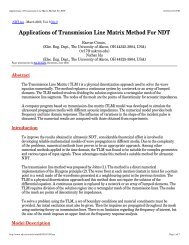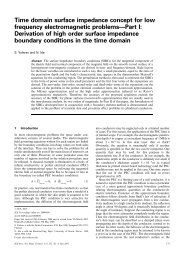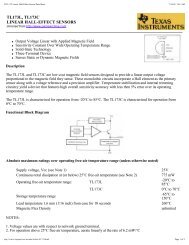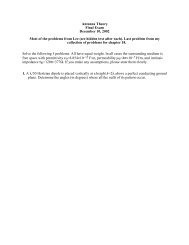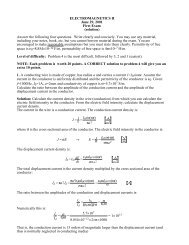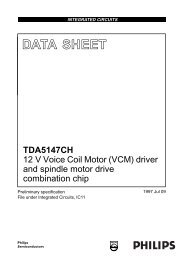Use of Transmission Line Methods for Antenna Analysis and Wave
Use of Transmission Line Methods for Antenna Analysis and Wave
Use of Transmission Line Methods for Antenna Analysis and Wave
Create successful ePaper yourself
Turn your PDF publications into a flip-book with our unique Google optimized e-Paper software.
Progress in Electromagnetic Research Symposium 2004, Pisa, Italy, March 28 - 31<strong>Use</strong> <strong>of</strong> <strong>Transmission</strong> <strong>Line</strong> <strong>Methods</strong> <strong>for</strong> <strong>Antenna</strong> <strong>Analysis</strong> <strong>and</strong> <strong>Wave</strong>PropagationN. IdaThe University <strong>of</strong> AkronElectrical <strong>and</strong> Computer Engi.Akron OH, 44325-3904,USAe-mail: ida@uakron.eduR. CiocanClemson UniversityPhysics <strong>and</strong> Astronomy Dept.Clemson, SC 29634-0978,USAe-mail: ciocan@clemson.eduAbstractThe transmission line method (TLM) is almost ideally suited <strong>for</strong> computation <strong>of</strong> wave propagationin the presence <strong>of</strong> various media as well as to the representation <strong>of</strong> sources, including antennas. Beinga time domain method, it requires few assumption on the shape or frequency <strong>of</strong> the source wave<strong>for</strong>m.It can h<strong>and</strong>le a variety <strong>of</strong> interface conditions as well as material properties including lossy media <strong>and</strong>perfect conductors. Following a brief introduction to the method <strong>and</strong> its <strong>for</strong>mulation <strong>for</strong> perfectdielectrics <strong>and</strong> conductors we discuss the extension <strong>of</strong> the method <strong>for</strong> inclusion <strong>of</strong> lossy dielectrics,placing the method in perspective relative to other time-domain methods suitable <strong>for</strong> wavepropagation <strong>and</strong> <strong>for</strong> modeling <strong>of</strong> antennas. In this paper we chose to emphasize the interaction <strong>of</strong>antenna fields <strong>and</strong> conducting grids with particular application to modeling <strong>of</strong> shielding effects inrelatively widely spaced grids. This in turns has application to shielding <strong>of</strong> MRI signals. A secondfocus point <strong>of</strong> the paper is the use <strong>of</strong> the transmission line method <strong>for</strong> the design <strong>of</strong> antenna adaptivearrays including driving coefficients <strong>and</strong> beam shaping parameters. While we will constrain ourselvesto simple linear arrays <strong>of</strong> dipoles, <strong>for</strong> which analytical solutions can be used <strong>for</strong> comparison, themethod is fully exp<strong>and</strong>able to any antenna element <strong>and</strong> array configuration.The TLM MethodThe transmission line matrix was proven to be a very powerful method in modeling complexgeometries. This paper explores the capability <strong>of</strong> the method to deal with various types <strong>of</strong> input signals<strong>and</strong> in particular, signals related to antennas <strong>and</strong> wave propagation. The TLM method was introducedin 1971 [1]. The capabilities <strong>of</strong> the method in modeling <strong>of</strong> radar applications were demonstratedelsewhere [2]. The accuracy necessary <strong>for</strong> antenna applications required the development <strong>of</strong> a newtype <strong>of</strong> node <strong>for</strong> an antenna with axial symmetry [3]. The TLM method is limited only by the amount<strong>of</strong> memory storage required, which depends on the complexity <strong>of</strong> the problem to be modeled. It wasfound that <strong>for</strong> the same problem a TLM model provides higher accuracy in solution compared with theFinite Difference Time Domain (FDTD) method [4]. The price <strong>for</strong> this is an increased number <strong>of</strong>computer operations as compared with FDTD. The TLM based model has other three majoradvantages compared to the FDTD model: the TLM method is an unconditionally stable numericalmethod; there are no restrictions on the geometries to be modeled <strong>and</strong> any type <strong>of</strong> field sources can beimplemented in a TLM model.There is an equivalence between the field quantities (electric <strong>and</strong> magnetic field intensities) <strong>and</strong>the transmission line quantities (voltage <strong>and</strong> current) [5-7]. Based on these equivalencies the wholespace can be treated as a network <strong>of</strong> lumped circuits. The smallest part <strong>of</strong> space that can be modeled iscalled node. For this node, the charge <strong>and</strong> flux conservation laws must be satisfied. The propagationproperties <strong>of</strong> this node are described by the so called scattering matrix (S lm ). The scattering matrixdetermines the output at all ports <strong>for</strong> a given input [6,7]. In a general <strong>for</strong>m, this can be written as:ri[ ] [ S ] [ V ]V = (1)llmm461
Progress in Electromagnetic Research Symposium 2004, Pisa, Italy, March 28 - 31Figure 2. The totald field distribution in they-z plane <strong>for</strong> z directed source. Propagation is from the left.ConclusionsA numerical model based on the transmission line method <strong>and</strong> suitable <strong>for</strong> antenna analysis as well as<strong>for</strong> general wave propagation problems was demonstrated. Sample applications to propagation throughan aperture <strong>and</strong> to antenna array patterns show the capabilities <strong>of</strong> the general model.REFERENCES1. Johns, P. B. Beurle, R. L. “ Numerical solution <strong>of</strong> two-dimensional scattering problems using atransmission-line matrix” Proc. IEEE, vol 118, pp 1203-1209, 1971.2. F.J. German, Gothard, G.K., Riggs L.S. "RCS <strong>of</strong> three dimensional scatters using the symmetricalcondensed TLM method ", Electron. Lett., 26(10), pp673-674),1990.3. S. L. Maguer, “ New TLM nodes with PML absorbing boundary conditions <strong>for</strong> the characterization <strong>of</strong>axially symmetric antenna”, Int. J. Numer. Model:14:185-203,2001.4. Allen R. Mallik A. Johns P. “ Numerical results <strong>for</strong> the symmetrical condensed TLM node” IEEETransaction on Microwave Theory <strong>and</strong> techniques , Vol MTT-35 , No.4 April,1987.5. Ida N., Engineering Electromagnetics , Springer pp.885-935, 2000.6. R. Ciocan <strong>and</strong> N. Ida, “<strong>Transmission</strong> line matrix model <strong>for</strong> detection <strong>of</strong> local changes in permeabilityusing a microwave technique,” to appear in IEEE Transactions on Magnetics, 2004.7. R.M. Ciocan, “Numerical models <strong>for</strong> elastic <strong>and</strong> electromagnetic wave propagation with applications tonondestructive characterization <strong>of</strong> materials,” Phd dissertation, The university <strong>of</strong> Akron, August 2003.8. C. Christopoulos, The <strong>Transmission</strong>-<strong>Line</strong> Modeling Method, IEEE Press, 19959. Balanis, C. “<strong>Antenna</strong> Theory <strong>and</strong> Design”John Wiley&Sons, Inc. pp.249-347464



